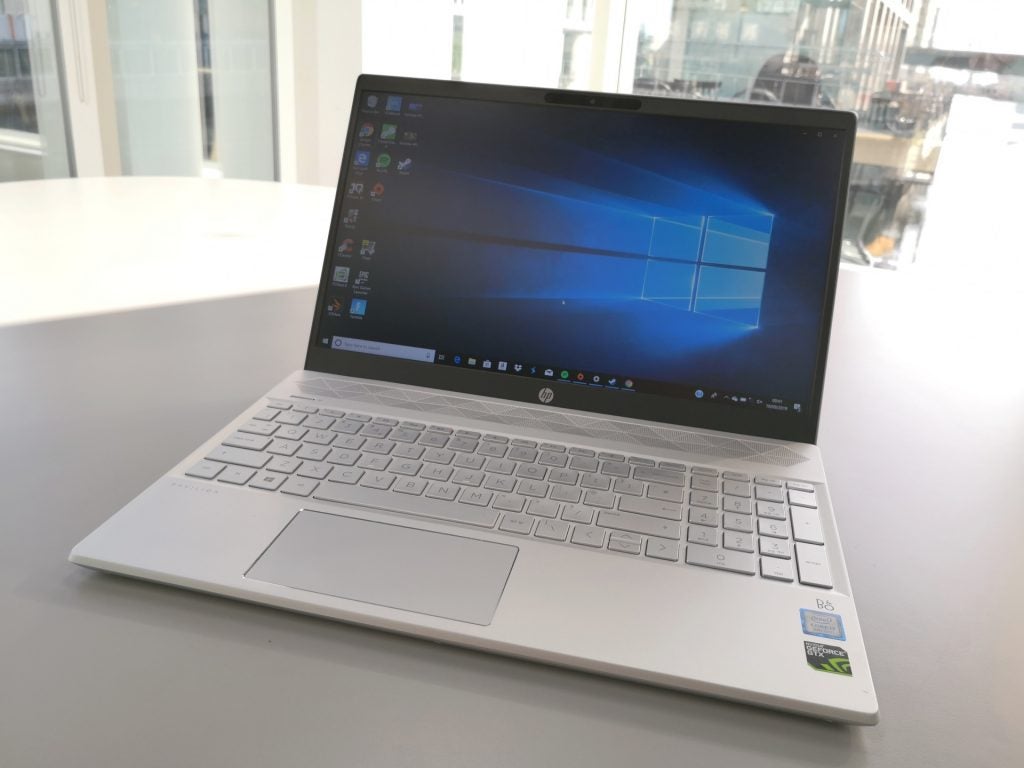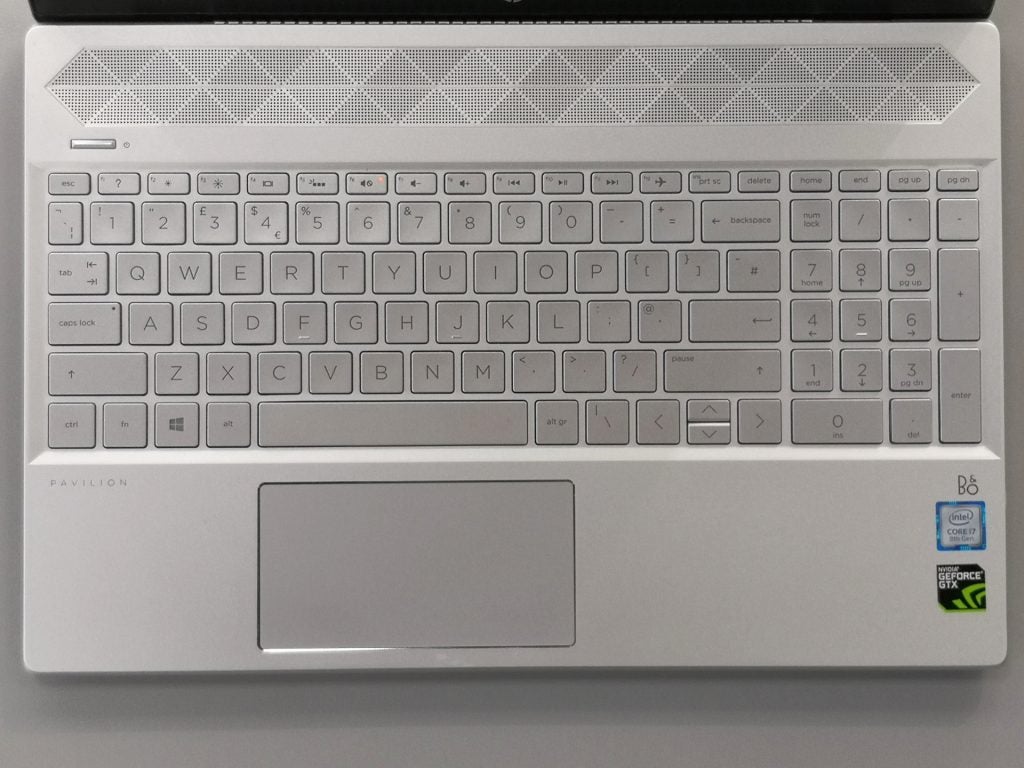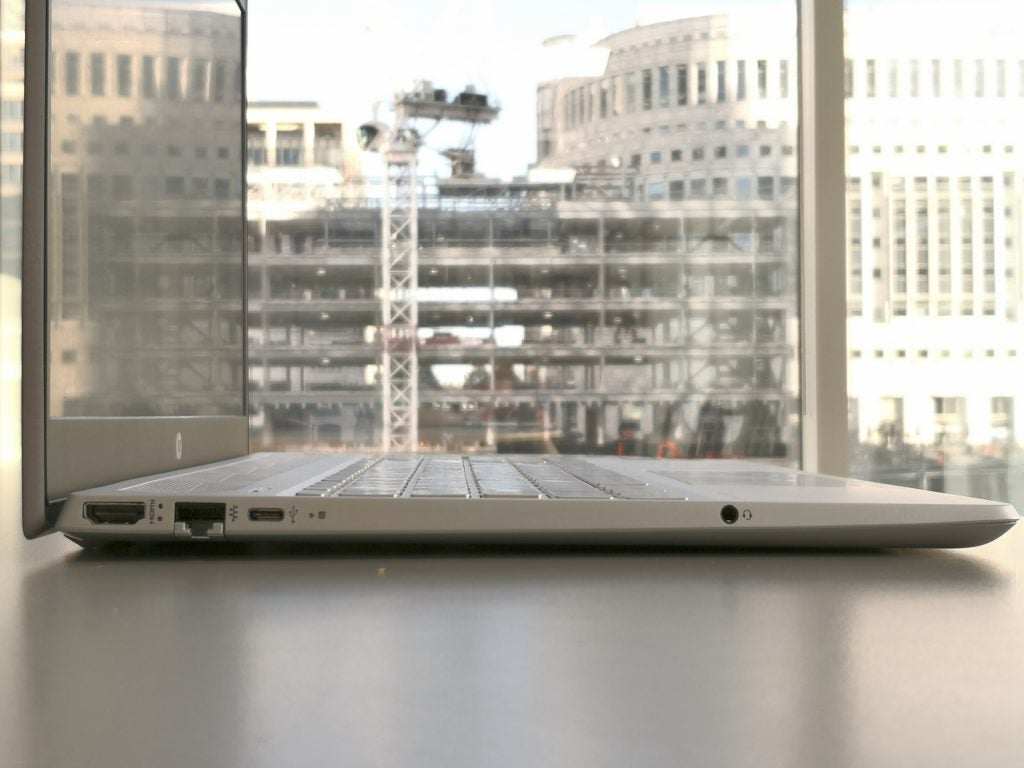HP Pavilion 15 Review
HP Pavilion 15 Review
An affordable but unspectacular lifestyle laptop

Verdict
With the first Ice Lake laptops just around the corner and the graphics processor here showing its age, it’s hard to justify dropping £850 on the HP Pavilion 15. That said, there’s nothing really wrong with this laptop. If the price falls in the coming weeks and months, bargain hunters could make a killing.
Pros
- Nice keyboard
- Good speakers
- Well suited for office work
Cons
- Sub-average display
- Not fantastic value for money
Key Specifications
- Review Price: £850
- 15.6-inch Full HD display with IPS
- Intel Core i7-8565U processor
- Nvidia GeForce GTX 1050 Ti
- 8GB DDR4-2400MHz RAM
- 256GB PCIe NVMe M.2 SSD
- Type-C USB 3.1 Gen 1, 2 x Type-A USB 3.1 Gen 1, HDMI 1.4; Ethernet, 3.5mm audio jack
What is the HP Pavilion 15?
The HP Pavilion 15 is an affordable laptop that undercuts the majority of the competition, making it an ideal option for students and office workers to consider.
In the review unit I’ve been sent – the HP Pavilion 15-cs1506sa – there’s an Intel Core i7-8565U processor sitting under the hood, next to a Nvidia GTX 1050 Ti GPU. This means on paper you should have enough processing power to blast through basic PC tasks and enough GPU grunt to get in a bit of Fortnite, Overwatch and the like on the side – just don’t expect to to run these at a high clip with texture packs and settings cranked all the way up. There might be a dedicated graphics card here, but a high-end gaming laptop the HP Pavilion 15 is not.
That said, the price here is quite attractive – £850 at the time of writing – and means it competes directly with the likes of the Acer Nitro 5, which occupies the same price bracket but features more modern 16 Series cards, the Razer Blade Stealth (2019) and not to mention HP’s own Envy 13.
Related: Best Laptop 2019

The HP Pavilion 15 is all right angles and silver surfaces
HP Pavilion 15 design and features – Diamond geezer
The new HP Pavilion 15 is a fairly standard-looking Windows 10 laptop that features the micro-drilled, right-angled-triangles motif seen on other HP laptops such as the HP Envy 13 and the HP EliteBook 1050 G1. On this particular laptop, the interlocking triangles create a slightly retro diamond/elongated Zelda rupee shape.
Two speakers sit behind this triangular weave and, as with many HP laptops, the speakers have been tuned with help from high-end Danish audio brand Bang & Olufsen.
The HP Pavilion 15 is a fairly big laptop – measuring 361.6 x 241.6 x 17.9mm – with a full-sized keyboard, number pad, and the 15.6-inch display’s 5mm side bezels. In terms of ports, the right-hand side has two Type-A USB 3.1 Gen 1 ports, a lock slot, and a full-sized SD card reader, while the left-hand side has HDMI 1.4, Ethernet, and Type-C USB 3.1 ports, along with a 3.5mm headphone jack.
As with the HP Envy 13, Thunderbolt 3 technology isn’t present here, so the Type-C USB port will only transfer data at rates of up to 5Gbps (versus up to 40Gbps with Thunderbolt 3), but, then again, this is an £800 laptop and Thunderbolt 3 remains expensive to implement.
Another feature the HP Pavilion 15 has in common with the HP Envy 13 is that the shape of the case ensures the rear portion of the deck’s underside – where the air vent is located – is lifted up off the desk slightly when you open the laptop. This is a design feature we’ve seen on other laptops too – namely the Asus ZenBook range – and looks likely to become a standard feature of all Ultrabooks going forwards.
Weighing just shy of 2kg (1.89kg), the HP Pavilion 15 is a little heavier than most laptops in its category. Most lightweight Ultrabooks and notebooks these days are closer to the 1kg mark. While the HP Pavilion 15 is heavy by comparison, it’s still slight and slim enough to carry around all day in your satchel.
Related: Best Student Laptops 2019

Good travel and key action make typing on the HP Pavilion 15 effortless
HP Pavilion 15 keyboard – How easy is the HP Pavilion 15 to type on?
The HP Pavilion 15 is very easy to type on. The keys have a good amount of travel – not Lenovo ThinkPad T490 good but still deeper and nicer-feeling than most laptops – and gentle underlighting means you can work away late at night with ease.
The keycaps feel similar to those of the HP Envy 13, but because the HP Pavilion 15’ is bigger, there’s room for a number pad here. This (sort of) makes up for the arrow keys being small and hemmed in, and you could just use number lock and have the 2, 4, 8, and 6 keys double as arrow keys – problem solved.
Despite these layout gripes, the Pavilion 15’s keyboard is solid. Key action is nice and snappy, with little in the way of wobble from the letter keys. Shift, Caps Lock, Enter and Space Bar – the usual suspects – are all a little more on the wobbly side, but nothing here gives me immediate cause for concern. Everything feels sturdy and durable.
The trackpad was less easy to use out of the box, requiring me to whack the sensitivity level all the way up in order to be able to use this with any ease. After reviewing the Asus ZenBook 14, which features the slickest trackpad I’ve used in recent months, I think that all other laptop trackpads are ruined for me.

The keyboard layout here is generally good, though having the nav keys squashed in above the number pad is not ideal
HP Pavilion 15 speakers – Are the Bang & Olufsen speakers any good?
The speakers of the HP Pavilion 15 are very good, with only minimal distortion noticeable at maximum volume.
Dialogue on streamed Netflix and iPlayer content sounded crisp, as did most of the music I played while working on this review. It passed my Master of Puppets test – where I stream the classic Metallica track at 50% volume and note if there’s any obvious distortion – with all instruments sounding clear and defined.
Some music, such as solo piano and acoustic guitar – tracks where there’s a lot of resonance – did not sound great at high volumes. Steve Howe’s Mood for a Day, a recording which seems purpose-built to make laptop speakers rattle horribly, sounded muffled if pushed beyond 60% volume.
Generally speaking though, the speakers are very good and a notch above most. Music and dialogue is certainly better than you might expect to hear coming out of an £800 laptop.
HP Pavilion 15 display – Can I use the HP Pavilion 15 for photo editing?
The HP Pavilion 15’s display is not well suited to photo editing. Low maximum brightness and poor colour gamut coverage mean that I wouldn’t recommend this even for the most basic of photo work or digital art. Even if all you’re doing is resizing your holiday snaps, if you’re after a laptop for any kind of photo work, you’d be better off picking up something like the HP Envy 13 or the Razer Blade Stealth 13 (2019).
I recorded a maximum brightness of 223.55 nits using an X-Rite i1Display Pro colorimeter and DisplayCAL 3. That’s a poor score and explained why websites, photos, and games looked a little dull and washed out. If a laptop can’t give you at least 300 nits of maximum brightness in 2019, you should reconsider it.
That said, a low black level of 0.15 nits means that contrast is high – I recorded an acceptable contrast ratio of 1432:1, and while things were a little on the dull side, nothing looked excessively murky or washed out.
Colour gamut coverage was poor, however, with just 61.7% of the sRGB (Standard RGB) space covered. As the name suggests, sRGB is the standard colour space used by developers, website designers and digital artists, and as such is a good indicator of how vivid and vibrant websites, webcomics, or video game visuals will look on a display. Ideally, a display will give you 100% sRGB coverage but, in reality, any laptop display which covers 80% or above is good.
The wider Adobe RGB and DCI-P3 colour spaces are more of interest to digital photographers and videographers, and while you won’t be doing any heavy edits in Premiere Pro on the HP Pavilion 15, it’s worth mentioning the Adobe and DCI scores are very low – 42.9% and 44.0%, respectively. Again, that’s below par. You should hope for around 70% coverage of both of these colour spaces.
By contrast, the HP Envy 13 covered 69.2% and 71.7% of the Adobe RGB and DCI-P3 colour gamuts when I tested it.
Related: Intel Ice Lake

If you want Fortnite to look this pretty on the HP Pavilion 15, you can expect to cruise at 30fps most of the time
HP Pavilion 15 gaming – How well does it run Fortnite and Apex Legends?
Using FRAPS to measure game performance, I recorded average frame rates of around 30-40fps and 70-100fps on Fortnite with the graphics settings on Epic and Low respectively, and 20-30fps and 50-60fps on Apex Legends, with textures and shadows dialled all the way up, and all the way down.
While the 60Hz display means you won’t be able to appreciate the higher frame rates you can achieve on the HP Pavilion 15, you could always hook this up to a Full HD gaming monitor. HDMI 1.4 is old hat – it’s all about HDMI 2.1 these days – but it still supports 1080p video at 144Hz. So, if you are in the market for something to play battle royale shooters on, and you already own or are thinking about getting a cheap Full HD monitor anyway, you at least have the option of that as a workaround.
Don’t expect AAA titles like Control or The Division 2 to run well on this, though. I ran the in-game benchmark on Dirt Rally – a game from 2015 we still use in reviews to see how systems handle older games – and on Ultra settings, I got an average frames per second count of 44.95. I was only able to comfortably clear 60fps here when I dipped the graphics settings down to Medium, where the HP Pavilion 15 gave me 77.92fps on average, and a maximum fps count of 110.24.
Shadow of the Tomb Raider did not fare so well. I averaged 29fps and 30fps with the graphics set to High and Medium. Every time I tried to run the benchmark with visuals at the highest settings, the game crashed. In fairness, the HP Pavilion 15, with a graphics card from 2017, can’t be expected to run demanding titles well and it’s good enough for battle royale shooters and older PC games.
You will want to pick up a gaming mouse though, because when it comes to tense firefights, that trackpad is not your friend.
Related: Best gaming mouse

Ports on the left-hand side of the HP Pavilion 15 from left to right: HDMI 1.4, Ethernet, Type-C USB, 3.5mm audio jack
HP Pavilion 15 general performance – What’s the HP Pavilion 15 like for basic PC use?
The HP Pavilion 15 is absolutely fine for everyday PC office work. Despite average SSD read and write speeds, I did not struggle at any point to get through a day’s work on this.
While you might run into issues loading up multiple photos in Photoshop, GIMP or your freeware photo editing app of choice, this should not be a big deal since the screen isn’t really up to scratch for serious photo work anyway.
I ran PCMark 10, a general performance benchmark, and got a result of 4220. This is just shy of the 4500 baseline score PCMark 10 developer UL says indicates a PC is suitable for office work. For what it’s worth, in my experience the HP Pavilion 15 is fine in this regard and laptops that have returned scores of 4000 and just below have also been totally capable of running basic PC tasks, for example browsing the web with several tabs open, word processing, email and video calls.
Meanwhile, Geekbench 4 spat out scores similar to those I’ve seen on laptops powered by an Intel Core i7-8565U Whiskey Lake processor – 4668 on the single-core test, and 13,081 on the multicore test. I recorded similar scores when I ran the same test on the Lenovo ThinkPad T490s (4647, 13,742) and Dell XPS 13 (4281, 14,167). Both of these laptops feature the same Whiskey Lake processor. The HP Envy 13 model I tested returned similar scores, too (4877, 14,509), despite running on a less powerful Core i5 Whiskey Lake CPU.
In plain English, all of these numbers mean that, yes, the HP Pavilion 15 and its processor are perfectly fine for office work.
I also ran 3DMark’s Fire Strike benchmark, which is designed to test out the graphics rendering capabilities of a GPU, and got 5948, a fairly average score in this day and age. We’ve already established the HP Pavilion 15’s gaming credentials, so it’s not really worth going around the houses on this.
Finally, the CrystalDiskMark benchmark, which tests the read and write speeds of SSDs and hard drives, gave me an OK 1735.8MB/s read score, and a not-so-OK 742.90MB/s write speed. Saving large projects could take a while here, but if you’re storing most of your written work in Google Docs or Microsoft OneDrive, this is perhaps less of an issue.

Ports on the right-hand side of the HP Pavilion 15 from left to right: SD card reader, Kensington lock slot, 2 x Type-A USB ports
HP Pavilion 15 battery performance – Will the HP Pavilion 15 run all day long?
Broadly speaking, yes. In my experience, I’ve been able to get close to eight hours out of the HP Pavilion 15 off the mains, with the display’s brightness locked at 150 nits.
HP’s official spec sheet says you’ll be able to get over 16 hours on this, but in my experience that figure only makes sense if you’re really not doing much on the laptop. If you’re working – writing, cropping photos, sending and replying to several emails, all with music pumping in the background – you will be able to comfortably cruise through a working day without having to worry too much about reaching for the charger.
That said, running PC Mark 8’s Work benchmark, with the brightness pinned to 150 nits until the battery hit critical levels, gave me a result of three hours and three minutes, which is far below what I’ve observed in day-to-day use. I’m not sure why such an atypical result was returned, given that most Whiskey Lake laptops I’ve tested will give you something between eight to 11 hours off a single charge. The presence of a dedicated graphics processor is a factor – you can always manually disable this via the Nvidia Control Panel if you need to switch to the CPU’s integrated graphics.
Luckily, you can get the HP Pavilion 15’s 68 Wh li-ion battery topped back up to 100% in just over two hours. After half an hour of charging, expect to get 40% in the tank, and 69% after one hour.

Should I buy the HP Pavilion 15?
Given that you can get the Dell XPS 13 and the HP Envy 13 for not much more money right now, I would advise against buying an HP Pavilion 15, unless you’re able to pick one up in a Black Friday sale with a tidy discount.
Considering that it costs £850, and that we’ll be seeing laptops like the Acer Swift 5 – featuring next generation Intel Ice Lake laptop processors – going on sale very soon for about the same money, it is hard to justify dropping the better part of a grand on this right now.
There’s nothing terribly wrong with the HP Pavilion 15, but it’s coming to market with an outdated GPU, a not-terribly-good display and a price that very soon won’t be that competitive.
Your options are to either wait for the price to fall or pick up an alternative: if you want a cheap laptop for under £1000 to do basic PC work, pick up the HP Envy 13 instead. It’s smaller, but the overall experience is far better.
If you want a cheap laptop for light gaming, get an Acer Nitro 5, which is similarly priced and comes with 16 Series Nvidia graphics options instead of 10 Series. If you want something which straddles both camps, consider a Dell XPS 13 or a Razer Blade Stealth 13 (2019).
Verdict
A decent enough lifestyle laptop but currently overpriced for what you get.
How we test laptops
Unlike other sites, we test every laptop we review thoroughly over an extended period of time. We use industry standard tests to compare features properly. We’ll always tell you what we find. We never, ever, accept money to review a product.


